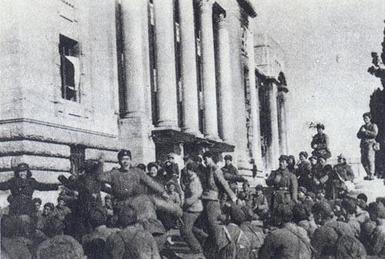On December 28th, 1950, Chinese troops crossed the 38th parallel into South Korea, officially beginning what would become known as the Korean War. This event marked a major turning point in the conflict between North and South Korea and ultimately led to a new era of foreign policy for the United States. In this blog post, we’ll explore why China decided to intervene in the Korean War and how it changed the course of the conflict.
1. The Background of the Conflict
The origins of the conflict can be traced back to 1945, when Japan’s surrender ended World War II. As part of its surrender agreement, Japan was forced to relinquish control of Korea, which Japanese forces had occupied since 1910. The U.S. and Soviet Union agreed to split control over Korea, with each occupying one-half of the country; this division would eventually become known as the 38th parallel.
By 1950, North Korea (under Soviet influence) and South Korea (under U.S. influence) were in a state of increased tension as differing ideologies clashed throughout Asia following World War II. On June 25th, 1950, North Korean forces crossed over into South Korea, sparking what became known as the “Korean War”. In response to this invasion, UN forces commanded by U.S. General Douglas MacArthur launched an attack on North Korea which pushed them back across the 38th parallel and nearly resulted in their complete defeat.
2. Why Did China Intervene?
At this point, China intervened on behalf of North Korea, sending troops across the 38th parallel to turn back UN forces and protect their ally from being defeated outright. This move put China at odds with both UN forces and U.S.-backed South Korean forces, as well as raising tensions between China and other countries around Asia who viewed Chinese intervention with suspicion or outright hostility. In order for China to justify its intervention, it argued that UN forces were attempting an illegal occupation of North Korea rather than providing aid or protection for South Koreans against North Korean aggression—a position which some historians have argued has some validity given MacArthur’s aggressive tactics during his command of UN forces in Korea.
3. About Chinese Troops in Korea
The People’s Volunteer Army (PVA) first entered North Korea in October 1950, and a total of approximately 780,000 troops served there until the armistice was signed in 1953. Although the PVA officially withdrew from the Korean War in May 1951, some units remained behind to provide support to the North Koreans in their fight against UN forces.
The Chinese troops played an important role in assisting the North Korean military during this conflict. They provided manpower, supplies, and weapons that helped to bolster the defenses of North Korea’s small army. Additionally, they used their knowledge of terrain and tactics to help outsmart more technologically advanced UN forces on several occasions.
Though western accounts of the conflict often overshadow them, Chinese troops played a crucial role in keeping the North Korean forces in the fight. This is especially notable considering that China had not yet fully recovered from its own civil war, which ended just two years earlier.
The most famous example of Chinese military aid to North Korea was when the Chinese troops entered the city of Pyongyang on October 19th, 1950. Their presence there helped disrupt UN plans for an assault on the city and forced them to withdraw their forces. In addition to fighting at Pyongyang, CPVA troops also took part in battles at other major cities, such as Chosin Reservoir and Incheon.
Chinese troops were also used in guerrilla warfare tactics against UN forces throughout the conflict. The terrain in North Korea provided ideal conditions for this type of warfare, and the Chinese used it to their advantage. This combat was integral in preventing UN forces from advancing further into North Korea and allowed them to retreat or evacuate when necessary.
China’s support for the North Korean forces extended beyond just military aid. In 1951, China established a “People’s Aid Center” in Pyongyang that helped families affected by the war with food, shelter, medical care, and other forms of assistance. It also provided money to fill in gaps left by international aid groups during times of extreme need.
The People’s Republic of China is still committed to maintaining its close ties with North Korea today. The two countries continue to cooperate on various economic and diplomatic fronts as well as in the security sector. While Chinese troops are no longer fighting in North Korea, their legacy of selfless devotion to a cause still lives on.
Together with the North Korean people, they helped defend their homeland against tremendous odds and remained an important part of modern-day Korean history. Without their assistance, it’s difficult to imagine what might have become of the country following the war. Today’s generation of Chinese soldiers can take pride in knowing that their predecessors played such a vital role in defending North Korea during one of its darkest periods.
3.1 Chinese Troops Efficiency
At first, China sought to stay out of the war but eventually changed its opinion due to concerns about US military presence on China’s doorstep and a fear that if South Korea won, then Taiwan could be next. On October 19th 1950, nearly 300,000 Chinese troops crossed into North Korea, effectively ending the UN advance.
The PVA was composed of various units, including infantry, armored cavalry, and artillery. They were well equipped with Soviet-made tanks and heavy weaponry. The Chinese troops were led by General Peng Dehuai, who had fought alongside Mao Zedong in the Chinese Civil War. He proved to be an effective commander and was able to reorganize his forces for battle against the South Koreans quickly.
The Chinese troops employed guerrilla tactics that made them very difficult to fight against. They moved fast and used deception to confuse their opponents. The PVA also showed considerable discipline in taking orders from their commanders, unlike some other Allied troops in Korea.
In addition to the PVA, the Chinese troops also included a number of volunteer militias consisting of North Korean refugees and civilians. These militiamen fought alongside the Chinese troops and provided valuable support in defending against UN forces.
Chinese troops proved to be very successful during the Korean War. By 1951, they had pushed back the UN forces and forced them into retreat. The PVA remained largely undefeated until an armistice was declared in 1953, marking the end of the war.
4. Consequences
The intervention of Chinese troops in December 1950 helped turn what had been a largely localized conflict between North and South Korea into an all-out war involving multiple nations from around the world. As a result of this intervention, UN forces were forced to retreat back across the 38th Parallel, where they remained until 1953 when both sides agreed to an armistice agreement that ended active hostilities on the peninsula but did not result in any peace treaty or the official resolution of hostilities between either side of this conflict. The tension between North and South still remains today as both countries remain divided along ideological lines despite numerous attempts at reunification over the last 70 years.
5. Crossing the 38th Parallel
The 38th parallel is a latitude line dividing North and South Korea. It was created in 1945 when the Allied Powers agreed to temporarily divide the peninsula into two occupation zones. Since then, it has become a symbol of tension between the two countries and a reminder of the atrocities committed during the Korean War (1950-53).
Crossing this border can be an emotional experience for many people due to its status as an international border. In theory, anyone who crosses it without permission could be considered an illegal immigrant or even a spy! As such, there are strict rules and regulations governing who may pass through each side.
Travelers wishing to cross the 38th parallel, they must obtain permission from both sides before doing so. This is done through the Joint Security Area (JSA), which consists of a small village on the border. Neutral third-party countries oversee the JSA from each side, who monitor the situation and ensure that only approved individuals cross the line.
The process of crossing can be lengthy and involved due to security protocol. Visitors must present valid passports and complete paperwork before they are allowed entry into either side. For many people, even just passing through this checkpoint can be emotional due to its history and significance in relation to the Korean War.
Once someone has been granted permission to pass through the checkpoint, they must follow strict rules while doing so. This includes not taking photographs or any other activity that would be considered suspicious in nature. Additionally, visitors must remain on designated paths and are not allowed to wander off into the surrounding countryside.
In recent years, North and South Korea have made steps towards reunification, with both sides actively working toward peaceful coexistence. Despite this, the 38th parallel still stands as a reminder of the conflict that once divided them. For many people, crossing this border is an emotional experience that serves as a symbol of hope for a better future. Chinese troops had more problems crossing the parallel than we have today.
6. Conclusion
On December 28th, 1950, Chinese troops crossed into South Korea, marking a significant turning point in the Korean War conflict between North and South Korea and ultimately leading to a new era of foreign policy for China and America.
While there are many disagreements about why exactly China decided to intervene, there is no denying that their involvement forever changed both sides ‘ strategies. It is also clear that despite all efforts, neither side achieved a complete victory which may be why this war is still remembered today.














